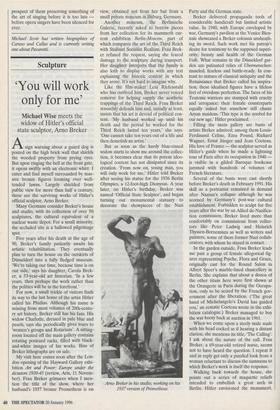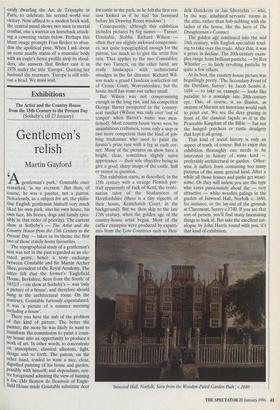Sculpture
`You will work only for me'
Michael Wise meets the widow of Hitler's official state sculptor, Arno Breker
Asign warning about a guard dog is posted on the high brick wall that shields the wooded property from prying eyes. But upon ringing the bell at the front gate, it opens swiftly with an electronic whirr. I enter and find myself surrounded by mas- sive bronze figures looming over well- tended lawns. Largely shielded from public view for more than half a century, these are the surviving works of Hitler's official sculptor, Arno Breker.
Many Germans consider Breker's house and studio, with its collection of over 50 sculptures, the cultural equivalent of a nuclear waste depot. For a small minority, the secluded site is a hallowed pilgrimage spot.
Five years after his death at the age of 90, Breker's family patiently awaits his artistic rehabilitation. They eventually plan to turn the house on the outskirts of Dusseldorf into a fully fledged museum. `We're taking our time, because time is on our side,' says his daughter, Carola Brek- er, a 33-year-old art historian. 'In a few years, then perhaps the work rather than the politics will be in the forefront.'
For now, a small trickle of visitors finds its way to the last home of the artist Hitler called his Phidias. Although his name is missing from most volumes of 20th-centu- ry art history, Breker still has his fans. His widow Charlotte, dressed in pale blue and pearls, says she periodically gives tours to `women's groups and Rotarians'. A sitting- room located off the main gallery contains rotating postcard racks, filled with black- and-white images of his works. Bins of Breker lithographs are on sale.
My visit here comes soon after the Lon- don opening of the Hayward Gallery exhi- bition Art and Power:• Europe under the dictators 1930-45 (review, Arts, 11 Novem- ber). Frau Breker grimaces when I men- tion the title of the show, where her husband's 1937 bronze Prometheus is on view, obtained not from her but from a small private museum in Bitburg, Germany.
Another museum, the Berlinische Galerie, recently asked to borrow pieces from her collection for its mammoth cur- rent exhibition Berlin-Moscow, part of which compares the art of the Third Reich with Stalinist Socialist Realism. Frau Brek- er refused the request, saying she feared damage to the sculpture during transport. Her daughter interjects that the family is also loth to display works with any text explaining the historic context in which they arose. It's not hard to imagine why.
Like the film-maker Leni Riefenstahl who has outlived him, Breker never voiced remorse for helping supply the aesthetic trappings of the Third Reich. Frau Breker staunchly defends him and, initially at least, insists that his art is devoid of political con- tent. 'My husband worked up until his death and the period he worked for the Third Reich lasted ten years,' she says. `One cannot take ten years out of a life and then demolish an artist.'
But as soon as the hardy blue-rinsed widow starts to show me around the collec- tion, it becomes clear that its potent ideo- logical content has not dissipated since its creation. 'From now on, young man, you will only work for me,' Hitler told Breker after seeing his statue for the 1936 Berlin Olympics, a 12-foot-high Dionysus. A year later, on Hitler's birthday, Breker was named 'Official State Sculptor', and began turning out monumental statuary to decorate the showpieces of the Nazi Arno Breker in his studio, working on his 1937 version of Prometheus. Party and the German state.
Breker delivered propaganda tools of considerable handicraft but limited artistic value. In 1940, with Europe enveloped by war, Germany's pavilion at the Venice Bien- nale showcased a Breker colossus unsheath- ing its sword. Such work met his patron's desire for testimony to the supposed superi- ority, beauty and health of the German Volk What remains in the Diisseldorf gar- den are patinated relics of Ubermenschen: muscled, fearless and battle-ready. In con- trast to statues of classical antiquity and the Renaissance that Breker called his inspira- tion, these idealised figures have a lifeless feel of overdone perfection. The faces of his Teutonic warriors are stamped with cruelty and arrogance; their female counterparts equally naked but somehow still chaste Aryan maidens. 'This type is the symbol for our new age,' Hitler proclaimed.
Filling the main gallery are busts of artists Breker admired; among them Louis- Ferdinand Celine, Ezra Pound, Richard Wagner, Ernst Jiinger and Jean Cocteau. His love of France — the sculptor served as Hitler's guide when he made a lightning tour of Paris after its occupation in 1940 is visible in a gilded Baroque bookcase jammed with hundreds of volumes of French literature.
Several of the busts were cast shortly before Breker's death in February 1991. His skill as a portraitist remained in demand after Nazism's collapse although he was scorned by Germany's post-war cultural establishment. Forbidden to sculpt for five years after the war by an Allied de-Nazifica- tion commission, Breker lived more than comfortably on commissions from collec- tors like Peter Ludwig and Heinrich Thyssen-Bornemisza as well as writers and painters, some of them former Nazi collab- orators, with whom he stayed in contact.
In the garden outside, Frau Breker leads me past a group of female allegorical fig- ures representing Psyche, Flora and Grace, originally cast for the Round Salon in Albert Speer's marble-lined chancellery in Berlin. She explains that about a dozen of the other titans here were first shown at the Orangerie in Paris during the Occupa- tion, only to be seized by the French gov- ernment after the liberation. (`The great hand of Michelangelo's David has guided you,' an ecstatic Cocteau wrote in the exhi- bition catalogue.) Breker managed to buy the war booty back at auction in 1961.
When we come upon a steely male nude with his head cocked as if hearing a distant clarion, she mentions its title, 'The Calling'. I ask about the nature of the call. Frau Breker, a 69-year-old retired nurse, seems not to have heard the question. I repeat it and in reply get only a puzzled look from a woman reluctant to discuss the summons to which Breker's work is itself the response.
Walking back towards the house, she points out a series of maquette reliefs intended to embellish a great arch in Berlin. Hitler envisioned the monument, easily dwarfing the Arc de Triomphe in Paris, to celebrate his second world war victory. Now affixed to a modest brick wall, the central panel shows two men in mortal combat, one a warrior on horseback attack- ing a cowering victim below. Perhaps this blunt image prompts Frau Breker to aban- don the apolitical pose. When I ask about an eerie nearby statue of a muscular body with an eagle's fierce profile atop its shoul- ders, she answers that Breker cast it in 1978 under the title 'Europa'. Quoting her husband she murmurs, 'Europe is still with- out a head. We must wait.'



























































 Previous page
Previous page